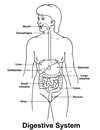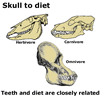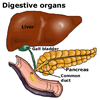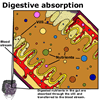 The
food we eat is usually very complex (see Food:
The chemicals of life) and our bodies cannot use it in this form.
Most animals, including humans, have evolved a system that breaks down
the complex molecules in our food into simple units that can be easily
absorbed and transported throughout the body by the bloodstream.
The
food we eat is usually very complex (see Food:
The chemicals of life) and our bodies cannot use it in this form.
Most animals, including humans, have evolved a system that breaks down
the complex molecules in our food into simple units that can be easily
absorbed and transported throughout the body by the bloodstream.
The human digestive system is about 8 metres long. It has several main organs with specific roles contributing to the overall process of digestion.
Mouth
 The teeth start digestion by physically reducing the food into smaller
pieces (mechanical digestion). The canine teeth rip through flesh, the
incisors bite off chunks and the molars grind and mash. This is helped
by the rolling action of the tongue and the moistening effect of saliva.
Mechanical digestion increases the surface area of the food so that the
digestive juices can act more efficiently to break down the complex food
chemicals (chemical digestion).
The teeth start digestion by physically reducing the food into smaller
pieces (mechanical digestion). The canine teeth rip through flesh, the
incisors bite off chunks and the molars grind and mash. This is helped
by the rolling action of the tongue and the moistening effect of saliva.
Mechanical digestion increases the surface area of the food so that the
digestive juices can act more efficiently to break down the complex food
chemicals (chemical digestion).
Saliva lubricates the food for easy swallowing, as well as containing the enzymes needed to commence starch breakdown. Enzymes are protein molecules produced by specialised glands. These "digestive juices" increase the rate of chemical reactions, with a separate enzyme required for each specific reaction.
 The
epiglottis is a flap which prevents swallowed food entering the trachea
and lungs. Instead it
continues down the oesophagus (gullet) to the stomach.
The
epiglottis is a flap which prevents swallowed food entering the trachea
and lungs. Instead it
continues down the oesophagus (gullet) to the stomach.
Stomach
The strong muscle walls of the stomach churn the food to make a thick
"soup" (chyme). Acid and protein-digesting enzymes are added
to the chyme by specialised gland cells in the stomach wall. The acid
maximises the action of the protein-digesting enzymes. Mucus prevents
the acid and enzymes digesting the muscles of the stomach wall (which
are made of protein), although stress can reduce the effectiveness of
the mucus and cause ulcers. (The "burning" sensation in the
throat after vomiting is due to this acid.)
Small intestine
Food passes along the digestive tract by peristalsis, wave-like contractions
of the smooth muscle in the walls.

|
Peristalsis |
 Digestion of carbohydrates and protein is completed in the first
section of the small intestine (duodenum), involving enzymes from glands
in the intestine walls and the pancreas. Bile from the liver (stored in
the gall bladder) aids fat digestion.
Digestion of carbohydrates and protein is completed in the first
section of the small intestine (duodenum), involving enzymes from glands
in the intestine walls and the pancreas. Bile from the liver (stored in
the gall bladder) aids fat digestion.
 By the time food reaches the second section of the small intestine
(ileum), all food has been reduced to simple units (except for plant cellulose
"fibre" which passes through largely undigested).These simple
units are now absorbed into the bloodstream through the villi of the intestine
wall (see Systems, transport
and exchange). These capillary-rich folds increase the area for absorption
of nutrients to about 300 square metres.
By the time food reaches the second section of the small intestine
(ileum), all food has been reduced to simple units (except for plant cellulose
"fibre" which passes through largely undigested).These simple
units are now absorbed into the bloodstream through the villi of the intestine
wall (see Systems, transport
and exchange). These capillary-rich folds increase the area for absorption
of nutrients to about 300 square metres.
Excess sugars are stored in the liver as glycogen. The hormones insulin and glucagon regulate the uptake or release of sugar to maintain a constant sugar level in the blood regardless of the body's activities.
The circulatory system then carries the absorbed nutrients from the liver to all parts of the body.
 Water loss is a major problem for organisms which live on land. Therefore
it is essential that water is reabsorbed from the chyme in the large intestine
to form the solid faeces containing fibre and other undigested food. These
are stored in the rectum and released through the anus by the anal sphincter
out of the body.
Water loss is a major problem for organisms which live on land. Therefore
it is essential that water is reabsorbed from the chyme in the large intestine
to form the solid faeces containing fibre and other undigested food. These
are stored in the rectum and released through the anus by the anal sphincter
out of the body.| Copyright owned by the State of Victoria (Department of Education and Early Childhood Development). Used with Permission. |